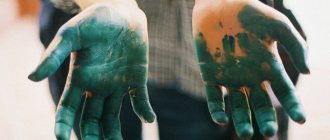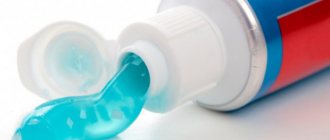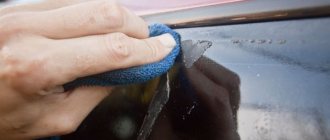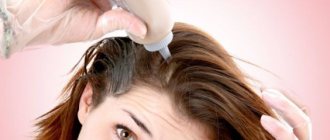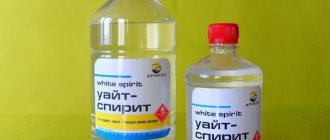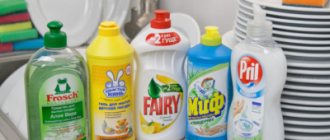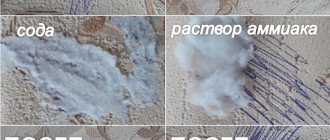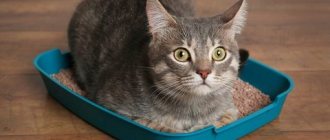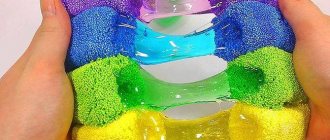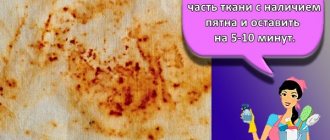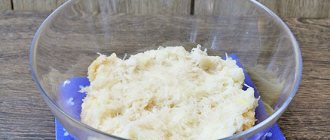Angelina
A week ago, a child splashed greenery in the kitchen. Seeing green specks all over the linoleum, I immediately began to figure out how to wipe off the green from the linoleum. I didn’t find any advice on the manufacturers’ websites, but I found a lot of recommendations on the forums.
There are a lot of tips on the Internet for removing green stuff. Most of them do not work, and in this article I will show this with real examples.
I tried seven methods and will share the results with you.
Preparatory stage
| Immediately blot a fresh stain from brilliant green with a paper napkin, rag or cotton pad . Remove as much of the green stuff as possible before it gets absorbed and dries, forming a hard-to-remove layer |
| Don't rub stains. This will increase the size of the stain, just blot and change sides of the napkin to remove all the liquid. Do not smear the brilliant green on the surface |
| Cover large stains from brilliant green on linoleum with salt. Make a layer of at least 5 mm so that the salt absorbs the liquid. Leave the composition on the surface for 2-3 minutes |
| Collect the salt that has absorbed the green stuff . Place a piece of paper and carefully sweep everything off the linoleum with a sponge |
Features of removing stains from different types of linoleum
When choosing a method for removing stains from linoleum, it is worth taking into account the characteristics of a specific type of floor covering, since the risks of its possible damage by cleaning agents also depend on the material from which the linoleum is made.
All linoleum options can be divided into 3 types:
- baseless linoleum - has a small thickness, which is why it is more susceptible to the influence of aggressive chemicals and mechanical friction; when removing contaminants, gentle methods should be used - vinegar with soda or alcohol-based preparations;
- linoleum coating on a foamed PVC base - its thickness can reach 3.5 mm; is highly resistant to most chemical elements, as well as chlorine-containing substances;
- felt-based linoleum - the thickness of this type of flooring can reach up to 5 mm; It is highly durable and is not afraid of even strong mechanical friction and any detergents.
Photo gallery: types of linoleum
Baseless linoleum has the smallest thickness and low resistance to chemicals
Linoleum on a foamed PVC base is quite resistant to various means, but you should carefully monitor the process
Felt-based linoleum is the most durable and can be cleaned with almost any detergent
Method 1: nail polish remover
We collect everything you need:
|
| Apply a little nail polish remover to a cotton pad. Carefully remove dirt using sweeping movements. Remove the brilliant green solution in order |
| Result of work. The flooring is perfectly clean. There is not even the slightest trace of green on it. Little time is spent, no effort required. |
Method 2: baking soda and vinegar
| Sprinkle some baking soda over the green stains . Cover contamination with a layer of at least 5 mm |
| Pour vinegar or acetic acid over baking soda. A reaction will begin with violent foaming. Add vinegar a little at a time until the baking soda foams. It is recommended to leave the liquid for a few minutes |
| Wipe off the dirt with a cotton pad or cloth . Some people advise using a soft brush, but I didn’t have one on hand |
| Result of work. I rubbed very hard, but I couldn’t wash off the brilliant green. The stain became lighter, but did not disappear. Re-processing did not improve the situation |
First steps when spilling brilliant green on linoleum
The first step is to remove any liquid that has not been absorbed into the coating. Any hygroscopic material at hand is suitable for this: napkin, cotton wool, soft fabric, toilet paper. The green stain is gently blotted until completely absorbed. It is important to blot and not rub, increasing the area of the stain. You can sprinkle salt on the stain - the mineral will quickly absorb the excess.
Then you need to prepare warm soapy water, dip a sponge in it and thoroughly wash the contaminated area. Instead of soap, it is permissible to use powder or dishwashing detergent.
As a rule, after this procedure a mark is still noticeable, since the linoleum has had time to absorb the brilliant green solution.
Method 3: Eraser
| We take a hard rubber eraser and try to erase the brilliant green . Three firmly to remove dirt from the surface |
| Don't press the surface very hard . The elastic should be erased, but not damage the top layer of linoleum |
| Remove the eraser pieces . Check if the surface is damaged |
| Result of work. I rubbed until my hand got tired, but I couldn’t remove the stains from the linoleum. In 10 minutes a small edge was wiped off. I have structural linoleum. Maybe this method will work better in a smooth version |
Method 4: kerosene
We will prepare everything you need:
|
| Apply a small amount of kerosene to a cotton pad . Use moderate pressure to scrub the stain off the floor. |
| Result of work. The spots became a little lighter, but did not disappear. I tried pouring some kerosene on the stains first. The result is the same |
Method 5: solvent R-646
We prepare everything you need:
|
| Apply the solvent to a cotton pad . Soak the material well, this simplifies the work and speeds it up |
How to remove brilliant green from linoleum:
If the linoleum was fixed to the floor using cold welding, carefully use solvent on the seams. It eats away the adhesive |
| Result of work. The stain completely disappeared without any special effort or vigorous rubbing of the surface. The only negative is the strong smell of solvent. After removing stains, rinse the surface with warm water and a liquid cleaner. |
Green stains: radical methods for eliminating them
If none of the methods help get rid of antiseptic contamination, then you can resort to radical methods. But still, they should be used only in extreme cases, when the stain is in a visible place and spoils the appearance of the floor.
The area with the stain can be cut out and a new piece of linoleum glued on.
Radical cleaning methods include:
- The stained area can be carefully cut out. Afterwards, a clean piece is applied and secured. It works like a patch. To keep it firmly in place, you can use cold welding, and the pattern must be selected so that it matches exactly;
- A new piece of linoleum can be glued with double-sided tape. But it will look ugly, all the joints will stand out;
- In the room, you can rearrange the furniture and put a wardrobe, chest of drawers, or bed on the area with the stain. But it is worth assessing the situation; if the pollution is in the center of the room, then rearranging is unlikely to help;
- A carpet that can be laid in the room will help hide the stain. But you should be prepared for the fact that this product has a decent price.
Additionally, you can watch a video with options for cleaning brilliant green. They show different options for removing contamination; they will help clean even old linoleum or parquet, maintaining its quality and strength.
The main thing is to follow the recommendations and rules, then the unpleasant stains will completely disappear and not a trace will remain of them. Additionally, you need to take into account the type of coating, its condition, shade; the type of cleaner used depends on this.
Method 7: ammonia
What you need for work:
|
| Apply a small amount of ammonia to a cotton pad |
| Before washing the brilliant green from the linoleum, the stains can be poured with ammonia . This way they come off easier |
| Result of work. The spots are almost completely gone. After a couple of days the green paint appeared and I had to wipe it off again |
How to remove brilliant green from clothes
If you suddenly stain your clothes with brilliant green, then every minute counts. The sooner you start removing dirt, the better the results will be.
- To remove brilliant green, table vinegar 9% and soap suds are suitable. Apply vinegar with a cotton swab for 10 minutes, then moisten it generously with soap suds and leave for another 10 minutes. Then rinse and wash with laundry soap.
- For light-colored fabrics, bleach is suitable. Apply bleach and wash thoroughly with laundry soap.
- An ammonia solution will help, but when washed, the stain may appear again.
- Acetone and hydrogen peroxide remove stains very effectively.
- Salicylic acid can quickly and reliably remove brilliant green from clothes. This is a very effective way.
What they say on the forums
I haven't tried these methods, but people recommend them as effective.
1. Salicylic or boric alcohol , sold in pharmacies.
Cosmonautics:
Alcohol (salicylic or boric alcohol is sold in pharmacies), vodka will not be used.
Source www.u-mama.ru
2. Option of soaking stains with acetone and chalk or tooth powder. May damage surface
psnsergey: Sprinkle the affected area with chalk (tooth powder). Moisten with acetone. Wipe. Repeat several times. Principle: acetone dissolves, chalk absorbs. Chalk can be replaced with newsprint. One drawback: this is the removal of the top layer of linoleum and if the linoleum is unsuccessful, it will look very noticeable.
Source forum.ixbt.com
3. Option with multiple funds. But in the end, vinegar helped.
Alya13:
My daughter spilled the entire tube on the floor this summer. I called my husband, asked what to do, realized that there was nothing to do and they were waiting for me... in the evening at home and began to wash it. First I sprayed a lot of window cleaner with foam, but not all of it, then I scrubbed it with vodka, alcohol and nail polish remover, finally I googled it and there was some method, I remember exactly what with vinegar, I took a towel, poured it on and washed everything! There is not a trace and the color has not been eaten away. Just put on gloves, I burned my skin, I was so scared I forgot that vinegar corrodes
Source real-shopper.ru
How can you remove brilliant green from linoleum?
What to do if the green blot was not noticed or removed immediately, and now neither bleach nor peroxide helps, the green blot has ingrained itself into the linoleum and there is no way to remove it? For such cases there are tricks and methods.
Hydrogen peroxide
Hydrogen peroxide is a product that has proven itself as a cleaner. It is also used to remove traces of green paint on linoleum. This option has many advantages:
- low price;
- availability;
- safety when using.
Hydrogen peroxide is sold in various concentrations; a concentration of at least 6% is suitable for removing traces of green paint from linoleum.
Hydrogen peroxide is used not only for medical purposes, but also in cleaning, as it has the ability to remove stubborn dirt.
The process of cleaning linoleum from green paint occurs as follows:
- Apply a thick cloth, generously moistened with the preparation, to the stain left after careless handling of brilliant green.
- The fabric is left on the stain for at least 10 minutes so that the liquid acts on the ingrained dye.
- Next, the fabric is removed and the contaminated area is washed.
After removing the fabric, not only the stain will lighten, but also the area of the floor around it, so after treatment this area should be thoroughly washed to smooth out the transitions. It is worth repeating the procedure until you are satisfied with the result obtained.
Acetone and other organic solvents
Organic solvents are used to break down fats, prepare adhesives and impregnations, and remove dirt and deposits. These include acetone, gasoline, turpentine, white spirit, toluene and many others.
Acetone belongs to a group of organic solvents often used to remove various dyes
The advantage of these products is their high activity - they are almost guaranteed to remove any contaminants. The downside is that they also have an aggressive effect on the surface itself, so if used incorrectly, there is a risk of getting not a clean floor, but a discolored area of linoleum. In addition, when working with these products, one must not forget about safety precautions, as they can adversely affect health. When using solvents, you need to wear gloves and take care to protect your respiratory tract and eyesight.
In order to remove an old stain from green paint, do the following:
- Soak a cotton swab in solvent.
- Use blotting movements to treat the stained surface - the movements should be soft, and in no case should you put pressure on the tampon.
- As the cotton gets dirty, it should be replaced with clean one.
- Continue until the desired result is achieved.
The stain will gradually decrease in brightness, but it is worth monitoring the condition of the linoleum itself so that it does not lose its color. After cleaning the floor, it must be thoroughly washed with soapy water.
Green bottles have one significant drawback - a rubber stopper, which is difficult to get and even more difficult to hold in your hands when it finally gives in. This is how sloppy stains appeared on our relatively fresh linoleum. I hesitated and got confused, so by the time I started active cleaning, the stains had already dried and been absorbed, so it was not possible to remove them with a banal floor washing. The first thing that came to my mind was to use a solvent, fortunately, renovations were in full swing in the house and solvents were available and in stock. Acetone has a very unpleasant smell, so I opened all the windows, put on gloves and a respirator, and began to wipe the blots with a cotton swab. The spot suddenly began to fade and after 5 minutes disappeared completely.
Nail polish remover
You don’t always have any special products like acetone on hand. But nail polish remover can be found in almost any apartment where a woman lives. It can also be used to keep the floor clean.
To clean the floor from green stains, only a liquid that contains acetone is suitable - it is this ingredient that will affect the contamination. Gentle nail polish removers without acetone will not have such a cleansing effect.
Since the concentration of acetone in this solution is low, its harmful effect on linoleum is greatly reduced. Therefore, the method of cleaning the floor will be slightly different than when using acetone:
- A thick cloth is moistened in liquid and pressed against the stain for 20–25 minutes.
- After this period, the contaminated area is wiped, starting from the edges and moving towards the center;
- After this, the floor is thoroughly washed.
To clean the floor from dirt, use nail polish remover containing acetone.
Table vinegar and manganese
Table vinegar and potassium permanganate, popularly called potassium permanganate, are two preparations that can be found in almost every home. Combining them will give a mixture that can remove even old stains from green paint. Instructions for removing helenka stains using potassium permanganate and vinegar are as follows:
- crystals of potassium permanganate are added to vinegar (you should take a concentration of 9%) until a solution of bright crimson color is obtained;
- the resulting mixture is moistened with a sponge or cloth, which is used to blot the contaminated area;
- the stain will gradually change color - after the first treatment it will turn pink;
- repeating the procedure will lead to another change in color - the stain will turn brown;
- The stained area of the floor should be washed with warm water and dried.
And then 6% hydrogen peroxide comes into play, it will cope with the resulting yellowness - a cloth moistened with peroxide is applied to the stain and left for 2-3 minutes, if necessary, repeat the action, replacing the rag with a new and clean one.
A combination of potassium permanganate and table vinegar produces a solution that allows you to remove various stains
Table vinegar and baking soda
Another pair that can be found in the kitchen of almost any housewife. In addition to their widespread use for culinary purposes, they can also be used for cleaning.
To restore the original appearance of the floor covering, perform the following steps:
- soda and vinegar are combined in such a proportion that all the soda reacts, that is, it gets wet and begins to hiss;
- the resulting mass is applied in a thick layer to the stained area;
- Cover this mass with cling film or polyethylene on top and leave it like that for 5 minutes;
- The gruel is changed from time to time for a new one, until the desired result is achieved - the soda will dissolve and discolor the brilliant green, but at the same time interact with it and lose its properties.
After cleaning the floor, you should thoroughly wipe it with a cloth soaked in vinegar.
It is necessary to cover the soda with a film so that the reaction between soda and vinegar is directed deep into the linoleum. Otherwise, there will be no noticeable result.
Baking soda slaked with table vinegar is used not only for baking, but also for removing various contaminants.
Alcohol solution of camphor
Camphor alcohol is a drug used as an antiseptic, wound healing and analgesic. But the range of its use is not limited to this. Like many other pharmaceutical products, it has a lot of side effects that allow it to be used in other areas, including for removing stains of various origins.
Before using camphor alcohol, the area to be treated should be thoroughly washed with soapy water and wiped until dry. To clean the floor, take a cotton swab or just cotton wool - moisten it generously in alcohol and actively wipe the stain and the surrounding area with it. The alcohol will draw out the green stuff from the deep layers of linoleum, so the cotton wool will become dirty and will need to be regularly replaced with a new piece.
When the mark is completely discolored and is no longer visible, the entire area of the floor that has been treated should be wiped with a cloth moistened with table vinegar.
An alcohol solution of camphor is sold in pharmacies, but it can be used not only for medical purposes
Medical alcohol
Medical, also known as ethyl alcohol, is a multifunctional product for removing stains of various origins. Its effect in the case of brilliant green stains is that the solution of brilliant green is made on the basis of ethyl alcohol - thus, the alcohol dilutes the dried stain of brilliant green, transforming it back into a liquid state, which allows you to clean unnecessary traces.
To clean linoleum from green stains, you need to take the following steps:
- gauze folded in several layers is thoroughly soaked in alcohol;
- wipe the area of the stain with gauze, moving from the edges to the center;
- when the mark brightens and becomes less noticeable, apply a cloth moistened with alcohol to it;
- the fabric should lie on the stain for about two hours;
- If after this time the contamination has not completely disappeared, the steps should be repeated from the very beginning.
Medical alcohol differs from food alcohol in a higher degree of purification, that is, the absence of unnecessary impurities
Other means
Of course, the range of products that can cope with green stains, or at least lighten them slightly so that they are not noticeable, is not limited to those listed above. To clean linoleum you can also use:
- alcohol-containing products - for example, vodka or cologne; They differ unfavorably from medical alcohol by the percentage of alcohol content and the presence of various impurities, and sometimes dyes, which can adversely affect the condition of the floor covering;
- hydrochloric acid at a concentration of 3–5% is a potent agent, but dangerous to use, so safety precautions must be taken when using it; the acid is applied to the stain for several minutes, after which the area of contamination is thoroughly washed with warm water;
- bleach and any chlorine-containing bleaches can also negatively affect the health of the person using them; the preparations are applied to the green mark for several minutes (the exact time is indicated in the instructions for the product), after which they are washed off with water;
- tooth powder - nowadays you can rarely find it on the farm; the powder is mixed with water to form a paste, applied to the stain and left there for 2 hours, after which it is rubbed over the stain with an old toothbrush; if the trace is not completely removed, then you can carry out similar manipulations by taking table vinegar instead of water; after treatment, rinse the floor with water;
- stain remover or laundry detergent - they can effectively deal with slightly and shallowly ingrained puddles of green paint, and are usually available in any home.
Before using any of the recommended products, you should first apply it to an inconspicuous area. And if the material does not deteriorate, you can try to remove stains with it.
Video: how and how to remove brilliant green from linoleum - 7 ways
What to remember
- Act quickly . A fresh stain comes off very easily. Old stains may not be wiped off.
- Blot the stain . Remove excess greenery. This simplifies the work and prevents it from penetrating deep into the linoleum.
- Do not use abrasive products . They damage the surface and leave abrasions.
- Test the composition on an inconspicuous area of the floor . There are many options for linoleum, to make sure that the chosen product does not spoil the material - drip it in a corner or behind furniture.
